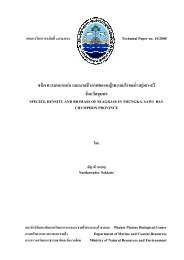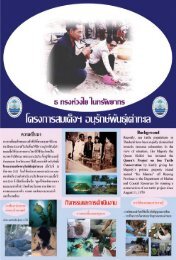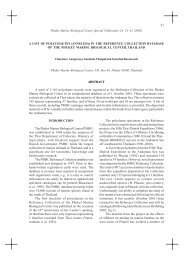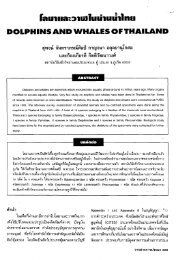(Dugong dugon) from Gulf of Thailand 1
(Dugong dugon) from Gulf of Thailand 1
(Dugong dugon) from Gulf of Thailand 1
You also want an ePaper? Increase the reach of your titles
YUMPU automatically turns print PDFs into web optimized ePapers that Google loves.
Analysis <strong>of</strong> stomach contents <strong>of</strong> <strong>dugon</strong>gs<br />
(<strong>Dugong</strong> <strong>dugon</strong>) <strong>from</strong> <strong>Gulf</strong> <strong>of</strong> <strong>Thailand</strong><br />
KANJANA ADULYANUKOSOL*, PANTARAK BOUKAEW AND ANUWAT PRASITTHIPORNKUL<br />
Phuket Marine Biological Center, P.O.box 60, Phuket, <strong>Thailand</strong><br />
* k-adulyan ukosol@yahoo. corn 1<br />
ABSTRACT 1<br />
During October 1994-March 2001, six stomach samples <strong>of</strong> strandedl<strong>dugon</strong>gs were collected <strong>from</strong> 4<br />
provinces in the <strong>Gulf</strong> <strong>of</strong> <strong>Thailand</strong> - 3 <strong>from</strong> Rayong Province, 1 <strong>from</strong> Chonburi province, 1 <strong>from</strong><br />
Chumporn Province and 1 <strong>from</strong> Surat Thani Province. Based on the inspection <strong>of</strong><br />
physio1morphological characters <strong>of</strong> leaves and epidermal cells, seagrass fragments were identified<br />
down to genuslspecies under stereo-and compound-microscopes. Five species <strong>of</strong> seagrass were<br />
found in the <strong>dugon</strong>g stomachs, their biomass were determined in terms <strong>of</strong> dry weight. The percentage<br />
<strong>of</strong> dry weight <strong>of</strong> each genuslspecies found in the stomach contents was as follows: Halophila (H.<br />
ovalis and H. decipiens) 9.97-55.43%, Halodule uninervis 0-37.4396, Thalassia hemprichii 0-2.2596,<br />
and Enhalus acoroides 0-1 3.74%. The frequency <strong>of</strong> occurrence <strong>of</strong> seagrasses in the stomachs ranged<br />
<strong>from</strong> the maximum to the minimum as follow: Halophila, Halodule, Enhalus and Thalassia. In addition,<br />
rhizome (1 3.99-45.49%) and algae (3.33-1 6.41 %) were found in all stomach samples.<br />
KEYWORDS : stomach content, <strong>dugon</strong>g, seagrass, biomass, <strong>Gulf</strong> <strong>of</strong> <strong>Thailand</strong><br />
INTRODUCTION<br />
<strong>Dugong</strong>s (<strong>Dugong</strong> <strong>dugon</strong>) are the extent<br />
herbivorous marine mammal in the tropicalsubtropical<br />
areas <strong>of</strong> the Indo-Pacific (Nishiwaki and<br />
Marsh, 1985). In <strong>Thailand</strong>, <strong>dugon</strong>gs have been<br />
found along the coastlines <strong>of</strong> both the <strong>Gulf</strong> <strong>of</strong><br />
<strong>Thailand</strong> and Andaman Sea. The largest group <strong>of</strong><br />
<strong>dugon</strong>gs inhabits around Talibong-Muk Islands,<br />
Trang Province (Aueng et al., 1993; Adulyanukosol<br />
et al., 1997; Hines and Adulyanukosol, 2001;<br />
Adulyanukosol, 2004). <strong>Dugong</strong>s are surviving by<br />
feeding on seagrasses (Hinsohn and Birch, 1972;<br />
Johnstone and Hudson, 1981; Marsh et al., 1982;<br />
Erflemeijer et al., 1993). There are a few studies on<br />
the precise composition <strong>of</strong> <strong>dugon</strong>gs diet, however,<br />
they were inconclusive as to whether <strong>dugon</strong>gs were<br />
selective in their grazing or not (Johnstone and<br />
Hudson, 1981). Heinsohn and Birch (1972) have<br />
reported that <strong>dugon</strong>gs in Townsville area <strong>of</strong><br />
Queensland fed exclusively on seagrass, selectively<br />
on Cyrnodocea spp. and Halodule spp. Heinsohn<br />
and Spain (1974) have recorded that brown algae,<br />
in addition to seagrasses, were eaten by <strong>dugon</strong>gs<br />
due to the destruction <strong>of</strong> seagrass meadows by<br />
tropical cyclones. In addition, the <strong>dugon</strong>gs<br />
occasionally fed on invertebrate, such as ascidians<br />
and polychaete, along with the seagrasses (Spain<br />
and Heinsohn, 1973; Lipkin, 1975; Marsh et al.,<br />
1982; Preen, 1995, Adulyanukosol et al., 2001).<br />
Johnstone and Hudson (1981) have found the leaf<br />
<strong>of</strong> Avicenia marina in a <strong>dugon</strong>g's mouth as well.<br />
While Nair et al. (1975) have reported that the .main<br />
food <strong>of</strong> the <strong>dugon</strong>g in Mandapam, India was<br />
Cyrnodocea serrulata. Moreover, the <strong>dugon</strong>gs at the<br />
Central Marine Fisheries Research Institute were<br />
fed with C. serrulata and Halodule uninervis.<br />
Adulyanukosol et al. (2001) have found 9 species<br />
<strong>of</strong> seagrass in the stomach samples <strong>from</strong> Trang<br />
province, <strong>Thailand</strong>, and 2 genera, Halodule and<br />
Halophila, were found in all stomach samples.<br />
The purpose <strong>of</strong> this study is to determine the<br />
composition <strong>of</strong> food in the <strong>dugon</strong>g stomachs and<br />
the relation <strong>of</strong> seagrasses found in the stomach to<br />
the species <strong>of</strong> seagrass in the catch area.<br />
MATERIALS AND METHODS<br />
Six stomach samples were collected <strong>from</strong> the dead<br />
<strong>dugon</strong>gs during 1994-2001 <strong>from</strong> 4 provinces<br />
located in the <strong>Gulf</strong> <strong>of</strong> <strong>Thailand</strong>; 3 <strong>dugon</strong>gs £rom<br />
Rayong Province and another 3 <strong>dugon</strong>gs <strong>from</strong><br />
Chonburi, Chumporn and Surat Thani Provinces<br />
(Fig. 1).
-..-<br />
<strong>Gulf</strong> <strong>of</strong> <strong>Thailand</strong><br />
~rmqkhla<br />
5r+,rl,<br />
PRW~II<br />
Nrra<br />
Figure 1. Map shows 4 areas where the specimens found.<br />
After measuring external characteristics and<br />
weighing the <strong>dugon</strong>g carcasses, the internal organs<br />
were inspected (measuring, weighing including<br />
parasite collecting). The measurements <strong>of</strong> the<br />
stomach samples were the maximum lateral<br />
diameter <strong>of</strong> the stomach through the esophagus,<br />
weight and pH in 3 regions <strong>of</strong> each stomach using<br />
pH paper (Fig. 2a). Then the stomach content was<br />
weighed and preserved in 10% formalin. After well<br />
mixing <strong>of</strong> each stomach content, 3 sub-samples,<br />
about 5 gm wet weight each, were inspected.<br />
Samples were identified down to genuslspecies<br />
under stereo-and compound-microscopes basing on<br />
physio/morphological characters <strong>of</strong> leaves and<br />
epidermal cells <strong>of</strong> seagrass fragments following the<br />
method <strong>of</strong> Channels and Momssey (1981),<br />
Adulyanukosol et al. (2001) and Adulyanukosol<br />
and Poovachiranon (2003). Halophila ovalis and H.<br />
decipiens were group as "Halophila". There was no<br />
attempt to identify the rhizome and root <strong>of</strong> seagrass<br />
into species so they were grouped as "rhizome".<br />
Detritus, rotten seagrass fragments, and<br />
unidentified materials were grouped as "others".<br />
Algae were treated as a single species. Biomass <strong>of</strong><br />
each generalspecies <strong>of</strong> seagrasses was measured as<br />
well. General information <strong>of</strong> 6 specimens are given<br />
in Table 1.<br />
Table 1. General information <strong>of</strong> the 6 <strong>dugon</strong>gs in this study, stomach contents, and pH <strong>of</strong> the stomach including<br />
small and large intestines. (W=Width, L=Length, Wt=Weight, M=Male, F=Female, Sto =Stomach, Lat<br />
dia= lateral diameter, fd= food, Nemt= Nematode, Bd wt=Body weight, Si=Small intestine, Li=Large<br />
intestine, - = no information).<br />
Number<br />
(ID-No)<br />
Ray-1<br />
(Du-030)<br />
Ray-2<br />
Date<br />
7110194<br />
1511019<br />
Locations<br />
Kew bay, Samet Is.,<br />
Rayong<br />
MannokIs.,Klaeng,<br />
L<br />
(m)<br />
2.42<br />
2.14<br />
Wt<br />
(kg)<br />
-<br />
180<br />
Sex<br />
F<br />
M<br />
St0<br />
Lat<br />
dia<br />
(cm)<br />
24<br />
fd<br />
(kg)<br />
2.0<br />
%fo<br />
od/<br />
Bd<br />
wt<br />
1.11<br />
Nemt<br />
(ind)<br />
55<br />
St0<br />
3-7<br />
pH<br />
Si<br />
7<br />
Li<br />
8<br />
I mu-088) I I Surat Thani I I I I I I I I I I I
Figure 2. a) stomach <strong>of</strong> <strong>dugon</strong>g shows the lateral diameter (Lat dai) and 3 regions <strong>of</strong> pH measurement, b)<br />
general feature <strong>of</strong> food in the <strong>dugon</strong>g stomach, mainly seagrass fragments with yellowish brown color<br />
and the small picture shows the nematode, Paradujardinia halichoris, commonly found in the stomach<br />
<strong>of</strong> <strong>dugon</strong>gs.<br />
RESULT<br />
In this study, 6 <strong>dugon</strong>gs were 3 males and 3<br />
females and the sizes <strong>of</strong> the <strong>dugon</strong>g ranged <strong>from</strong><br />
1.09-2.42 m in length and 27.8-228 kg in weight<br />
(Table 1). The maximum lateral diameter <strong>of</strong> the<br />
stomach through the esophagus length ranged <strong>from</strong><br />
10.1-28 cm. In general, the food in the stomach<br />
samples was mainly seagrass fragments with<br />
yellowish brown color and dry (Fig 2b).<br />
Nevertheless, some mucus was observed in the food<br />
that attached to the sac wall. The percentage <strong>of</strong><br />
food per body weight was between 0.46-3.86. The<br />
values <strong>of</strong> pH in the stomach, small intestine, and<br />
large intestine ranged <strong>from</strong> 2 to 7,5 to 7, and 6 to 8,<br />
respectively. The nematode, Paradujardinia<br />
halichoris was found in Ray-2 and Chp-1; 55 and<br />
160 individuals, respectively ((Table 1, Fig. 2b).<br />
Frequency <strong>of</strong> occurrence<br />
The frequency <strong>of</strong> occurrence <strong>of</strong> seagrasses in the<br />
stomachs ranged <strong>from</strong> the maximum to the<br />
minimum as follow: Halophila, Halodule, Enhalus<br />
and Thalassia (Fig. 3). Halophila ovalis and H.<br />
decipiens were found in all stomach samples (Fig.<br />
4a and 4b). The different morphology <strong>of</strong> the tip <strong>of</strong><br />
the leaves Halodule uninervis was found (Fig. 4c).<br />
Rhizome, algae and other materials were found in<br />
all stomachs as well. Large pieces <strong>of</strong> algae (about 2<br />
cm in length) were observed in the food <strong>of</strong> Chb-1<br />
and 2 major kinds <strong>of</strong> the algae found were<br />
Sargassum sp. and Caulerpa rnaxicana (Fig. 4d).<br />
Halophila Halodule Enhalus Thalassla RMzwne Algae Otherr<br />
Figure 3. Percentage <strong>of</strong> the frequency <strong>of</strong> occurrence <strong>of</strong> 4 genera <strong>of</strong> seagrasses (Halophila, Halodule, Enhalus<br />
and Thalassia), rhizome, algae and others found in 6 stomach samples.
-e 4. The samples <strong>from</strong> the stomach contents; a) leaf-fragment <strong>of</strong> Halophila ovalis with clear cross veins,<br />
b) epidermal cells <strong>of</strong> Halophila decipiens show hair on both sides <strong>of</strong> the leaf with fine tooth on the leaf<br />
margins c) different morphology <strong>of</strong> the tip <strong>of</strong> the leaves Halodule uninervis, d) the large pieces <strong>of</strong><br />
Sargassum sp. (left) and Caulerpa maxicana found in stomach content <strong>of</strong> Chb-1 (right).<br />
Biomass (dry weight) <strong>of</strong> each component<br />
The average percentage <strong>of</strong> dry weight <strong>of</strong> each<br />
genuslspecies found in the stomach contents was as<br />
follow: Halophila (H. ovalis and H. decipiens)<br />
9.97-55.43%, Halodule uninervis, 0-37.43%,<br />
Thalassia hemprichii 0-2.25%, and Enhalus<br />
acoroides 0-13.74%. In addition, rhizome (13.99-<br />
45.49%) and algae (3.33-16.41%) were found in all<br />
stomach samples. Focusing on genus Halophila,<br />
which was found in all stomachs; H. ovalis was<br />
found in the greater proportion (>80%) than H.<br />
decipiens in Ray-1 and Sut-1 while another 4<br />
samples (Ray-2, Ray-3, Chb-1 and Chp-1) were on<br />
the contrary (Table 2).<br />
Table 2. The percentage <strong>of</strong> average dry weight <strong>of</strong><br />
seagrasses, rhizome, algae, and others<br />
found in the <strong>dugon</strong>g stomachs<br />
(Sp.=Species, Ho=Halophila ovalis,<br />
Hd=Halophila decipiens, Hu=Halodule<br />
uninervis, Th=Thalassia hemprichii,<br />
Ea=Enhalus acoroides, Rhi=Rhizome,<br />
Rhi<br />
~1~<br />
0th<br />
Alg=algae, Oth=Others, nf=not found,<br />
*=Ho>Hd, **=Hd>Ho)<br />
nf nf nf nf (3.89)<br />
13.99<br />
(6.78)<br />
3.33<br />
(2.94)<br />
7.51<br />
(1.88)<br />
38.63<br />
(3.93)<br />
10.68<br />
(2.72)<br />
6.45<br />
(4.33)<br />
45.49<br />
(2.97)<br />
3.4<br />
(2.69)<br />
5.29<br />
(1.34)<br />
42.63<br />
(4.83)<br />
7.46<br />
(3.17)<br />
2.51<br />
(4.35)<br />
30.25<br />
(2.61)<br />
16.41<br />
(4.91)<br />
6.99<br />
(6.41)<br />
32.88<br />
(7.37)<br />
7.15<br />
(6.50)<br />
3.34<br />
(5.79)
DISCUSSION<br />
Marsh et al. (1977) found that the pH <strong>of</strong> the<br />
contents <strong>of</strong> all regions <strong>of</strong> the main sac, <strong>of</strong> duodenal<br />
diverticula and <strong>of</strong> the proximal duodenum were 1-3,<br />
5-6 and 4-7 for all <strong>dugon</strong>gs tested, respectively. In<br />
this study, the pH in the stomach, small intestine,<br />
and large intestine ranged <strong>from</strong> 2 to 7,5 to 7, and 6<br />
to 8, respectively. Conspicuous infestations <strong>of</strong><br />
nematode, P. halichoris, were observed in almost<br />
all stomachs <strong>of</strong> the <strong>dugon</strong>gs examined, particularly<br />
the large infestation in the cardiac gland in both<br />
Thai <strong>dugon</strong>g and Australian <strong>dugon</strong>g. There was no<br />
sign <strong>of</strong> cellular reaction on the host tissue<br />
surrounding the nematode (Marsh et al., 1977;<br />
Adulyanukosol et al., 2001). However, in this study<br />
P. halichoris was found in only 2 specimens (Ray-2<br />
and Chp-1). Channels and Morrissey (1981) have<br />
mentioned that the digesta collected <strong>from</strong> the<br />
cardiac region <strong>of</strong> the main sac is the least digested,<br />
but we found no difference <strong>of</strong> the food in any<br />
region <strong>of</strong> the main sac. The results show relatively<br />
similar values in the amount <strong>of</strong> food per body<br />
weight between the <strong>dugon</strong>gs in this study (0.46-<br />
3.86%) and those <strong>of</strong> Trang samples (0.41-3.35%)<br />
(Table 1; Adulyanukosol et al., 2001). Although<br />
captive <strong>dugon</strong>gs usually require food about 8-10%<br />
<strong>of</strong> their body weights (Kataoka et al., 1995).<br />
Table 3. The seagrass species distributed in the areas in which the 6 <strong>dugon</strong>gs stranded and the seagrass species<br />
found in the specimens. Seagrass information referred <strong>from</strong> Lewmanomont et al. (1991),<br />
Nateekajanalap (1989), Aryuthaka and Poovachiranon (1994) and Potchana Boonyanate, personal<br />
communication. (Ho=Halophila ovalis, Hd=H. decipiens, Hm=H. minor, Hb=H. beccarii, Hu=Halodule<br />
uninervis, Th=Thalassia hemprichii, Ea=Enhalus acoroides, Rm=Ruppia maritima, RaY=Rayong Province,<br />
ChB=Chonburi Province, ChP=Chumporn Province, SuT=Surat Thani Province, x=seagrass in natural area,<br />
*=seagrass in stomach sample)<br />
I I Ray I Rav- I ChB I Chb-1 I ChP I Ch~l I SuT I Sut-1 I<br />
I I I I I I .. I I I<br />
Total I 6 3 1 4 1 4 1 ~ 1 ~ 1 2 1 26 11 5<br />
Remarks: Ho, Hb, Hd, Hp, Hu, Cs, Th, and Fa distribute in Trat Province; Hd, Hm, Hp, Hu and Fa distribute in Chantaburi<br />
Province.<br />
The relationship between seagrass found in the<br />
stomach and surrounding habitat <strong>of</strong> stranding<br />
place<br />
Two to five species <strong>of</strong> seagrass distributed in each<br />
province <strong>of</strong> the study areas (Table 3). The total <strong>of</strong> 5<br />
species <strong>of</strong> seagrass were found in the stomachs<br />
(ranged <strong>from</strong> 1 to 5 species each specimen). If<br />
focusing on the locations in which the <strong>dugon</strong>gs<br />
were stranded, we can consider the coast <strong>of</strong> the<br />
<strong>Gulf</strong> into 2 parts; eastern <strong>Gulf</strong> (Chonburi to Trat<br />
Provinces) and western <strong>Gulf</strong> (Petchaburi to<br />
Narathiwat Provinces) (Fig. 1). There are 6 species<br />
<strong>of</strong> seagrass distributed in Rayong coast.<br />
Three <strong>dugon</strong>gs (Ray-1, Ray-2 and Ray-3) <strong>from</strong><br />
Rayong Province<br />
Three <strong>dugon</strong>gs coming <strong>from</strong> Rayong province<br />
(Ray-1, Ray-2 and Ray-3) have 4, 3 and 3 species<br />
<strong>of</strong> seagrass in the stomachs, respectively (Table 3).<br />
All seagrass species found in the stomachs <strong>of</strong> those<br />
<strong>dugon</strong>gs <strong>from</strong> Rayong distribute in the coast <strong>of</strong><br />
stomachs <strong>of</strong> Ray-1 and Ray-3. Considering the<br />
nearby area <strong>of</strong> Rayong in Chantaburi and Trat<br />
Provinces, 3 more species were found; Cymodocea<br />
serrulata, Thalassia hemprichii and E. acoroides.<br />
In this case, E. acoroides may distribute in some<br />
area <strong>of</strong> Rayong or the <strong>dugon</strong>gs may feed on E.<br />
acoroides in Chantaburi or Trat during their travel.<br />
Although 2 species <strong>of</strong> Halodule (H. pinifolia and H.<br />
uninervis) distributed in Rayong, but only the tip <strong>of</strong><br />
H. uninervis leaf was found. However, there might<br />
have H. pinifolia in the stomach contents because<br />
the epidermal cells <strong>of</strong> these two species are alike<br />
(Adulyanukosol et al., 2001). In general, the width<br />
<strong>of</strong> the leaf H. uninervis (0.25-3.5 mm) is wider than<br />
that <strong>of</strong> H. pinifolia (0.6-1.25 mm) (Hartog, 1970).<br />
Nevertheless, there is wide-leaf variety in H.<br />
uninervis; 0.25-0.35 mm in broad-leaf and less than<br />
0.1 rnm in narrow-leaf (Kuo and Hartog, 2001).<br />
Thus without leaf tip, it is hard to separate these<br />
Rayong except E. acoroides which was found in the two species (Adulyanukosol et al., 2001).
Chb-1, a calf <strong>from</strong> Chonburi Province<br />
Three species <strong>of</strong> seagrasses, H. decipiens, H. minor<br />
and Ruppia maritima, were recorded in Chonburi<br />
coast (Table 3). However it may not be necessary to<br />
focus on R. maritima because this species usually<br />
occurs in shrimp pond or brackish water area. The<br />
very young calf (Chb-1) fed on H. ovalis, H.<br />
decipiens and H. uninervis. Two species <strong>of</strong> its food<br />
(H. ovais and H. uninervis) was not found in the<br />
record <strong>of</strong> seagrass distribution in Chonburi. Perhaps<br />
these 2 species distribute in Chonburi waters or in<br />
the area close to Sattahip bay, where the <strong>dugon</strong>g<br />
was stranded. One more remark, the large pieces <strong>of</strong><br />
algae, Sargassum sp. and Caulerpa maricana<br />
(about 2 cm long) were found in its stomach (Fig.<br />
4d). Generally, algae in the <strong>dugon</strong>g stomachs were<br />
found in the smaller fragments than the seagrass<br />
leaves (Adulyanukosol et al., 2001). This is for the<br />
reason that the teeth <strong>of</strong> the calf did not grow very<br />
well including a restricted contact area <strong>of</strong> the teeth<br />
between upper and lower jaws when chewing.<br />
Chp-1 <strong>from</strong> Chumporn Province<br />
Only 2 species <strong>of</strong> seagrass (H. decipiens and E.<br />
acoroides) were reported in Chumporn Province<br />
and an only single genus <strong>of</strong> Halophila was found in<br />
the stomach <strong>of</strong> Chp-1 . Halophila combined higher<br />
proportion <strong>of</strong> H. decipiens with little amount <strong>of</strong> H.<br />
ovalis (Table 2, 3). The high biomass <strong>of</strong> Halophila<br />
in Du-078 reached 76.6 % (leaves 46.35 plus<br />
rhizome 30.25, Table 2). Surprisingly, a lot <strong>of</strong> H.<br />
decipiens (> 80% <strong>of</strong> Halophila group) were found<br />
in the specimens <strong>from</strong> the <strong>Gulf</strong>, particularly in Du-<br />
098, 130, 127 and 078 which were <strong>from</strong> Rayong,<br />
Chonburi, and Chumporn (Table 2 and 3) but it was<br />
rarely found in Trang samples (Adulyanukosol et<br />
al., 2001). This species distributes in deep area <strong>of</strong><br />
the Andaman Sea (Poovachiranon, 2000). Perhaps<br />
the distribution <strong>of</strong> this species in the <strong>Gulf</strong> is the<br />
same pattern as the Andaman. It is necessary to<br />
carry out more surveys <strong>of</strong> seagrass in deeper areas<br />
and remote islands <strong>of</strong> the <strong>Gulf</strong>.<br />
Sut-1 <strong>from</strong> Surat Thani Province<br />
Sut-l stranded in the south <strong>of</strong> Samui Island, Surat<br />
Thani. Six species <strong>of</strong> seagrass are available in Surat<br />
Thani Province and 5 species <strong>of</strong> those seagrass,<br />
excluding H. beccarii, were found in the food <strong>of</strong><br />
Sut-1. Mainly Halophila (H. ovalis > H. decipiens)<br />
was found and followed by Halodule uninervis<br />
(Table 2 and 3).<br />
Johnstone and Hudson (1981) have reported that<br />
the type and abundance <strong>of</strong> seagrass species in the<br />
<strong>dugon</strong>g may be related to the abundance, ecological<br />
distribution and energetic value <strong>of</strong> seagrass species<br />
in the catch area. While Adulyanukosol et al.<br />
(2001) have reported that the composition <strong>of</strong><br />
seagrass found in <strong>dugon</strong>g stomachs may relate to<br />
the composition presented in <strong>dugon</strong>g feeding<br />
ground since the seagrass species making up a large<br />
proportion in the stomach contents were apparently<br />
the dominant species found in the seagrass area<br />
nearby the places where the stranded <strong>dugon</strong>gs were<br />
collected. There are few studies on seagrasses in the<br />
<strong>Gulf</strong> <strong>of</strong> <strong>Thailand</strong>, particularly the abundance <strong>of</strong><br />
each seagrass species in each location <strong>of</strong> our study<br />
areas. Therefore, it is hard to notify the relationship<br />
between the foods found in the stomachs and the<br />
seagrass species in the catch areas. Nevertheless, it<br />
seems all <strong>dugon</strong>gs have fed mainly on the<br />
seagrasses available in the catch areas. Furthermore<br />
it is necessary to carry out more surveys <strong>of</strong> seagrass<br />
in the <strong>Gulf</strong>, especially the areas in which <strong>dugon</strong>gs<br />
still exist. The seagrass information including<br />
<strong>dugon</strong>g population assessment is very critically<br />
needed for establishment <strong>of</strong> <strong>Dugong</strong> and Seagrass<br />
Action Plan for <strong>Thailand</strong>.<br />
ACKNOWLEDGEMENTS ~<br />
We would like to say thank to all the people who<br />
supported the information and specimens <strong>of</strong> this<br />
study; Mr. Mickmin Charuchinda, Director <strong>of</strong><br />
Eastern Marine and Coastal Resources Research<br />
Center (EMCOR), Rayong Province including Mr.<br />
Somchai Man-anansap, Mr. Ranawan Boonprakob<br />
and Mr. Potchana Boonyanate <strong>from</strong> EMCOR; Mr.<br />
Sombat Poovachiranon <strong>from</strong> PMBC, Ms. Rattima<br />
Kuruwanchareon <strong>from</strong> Institute <strong>of</strong> Marine Science,<br />
Burapha University, Chonburi Province; Ass. Pr<strong>of</strong>.<br />
Chatcharee Kaewsuralikhit, Kasetsart University;<br />
Mr. Somphorn Meesangkaew, Deputy Director for<br />
Administration and Farms Affairs and Mr. Boonsin<br />
Jittapraphan, Deputy Director for Academic and<br />
Student Affairs, Maejo University at Chumporn<br />
Province; Mr. Virat Saengsod, Choksudarat-fishing<br />
port, Samui Island and Mr. Wittaya Sasithorn,<br />
Samui Snake Farm, Surat Thani province; Dr.<br />
Chatcharee Kaewsuralikhit <strong>from</strong> Kasetsart<br />
University for identification <strong>of</strong> algae and Dr. C. den<br />
Hartog for confirmation <strong>of</strong> Halodule uninervis; Ms.<br />
Palap Tiptus for editing the manuscript.<br />
REFERENCES<br />
Adulyanukosol, K. (2004). <strong>Dugong</strong> and conservation <strong>of</strong><br />
<strong>dugon</strong>g in <strong>Thailand</strong>. Phuket Marine Biological Center,<br />
Technical Paper No 5.53 pp. (in Thai)<br />
Adulyanukosol, K., Chantrapornsyl, S., and<br />
Poovachiranon, S. (1997). An aerial survey <strong>of</strong> <strong>dugon</strong>g<br />
(<strong>Dugong</strong> <strong>dugon</strong>) in Andarnan Coast, <strong>Thailand</strong>. Thai<br />
Fisheries Gazette. 50(5), 359-374. (in Thai)<br />
Adulyanukosol, K., Poovachiranon, S., and<br />
Natakuathung, P. (2001). Analysis <strong>of</strong> stomach contents<br />
<strong>of</strong> <strong>dugon</strong>gs (<strong>Dugong</strong> <strong>dugon</strong>) <strong>from</strong> Trang Province.<br />
Fisheries Gazette. 54(2), 129-137. (in Thai)
Adulyanukosol, K. and Poovachiranon, S. (2003). A Preen, A. (1995). Diet <strong>of</strong> <strong>dugon</strong>gs: Are they omnivores?<br />
pictorial key to generalspecies for identification <strong>of</strong> Jouml <strong>of</strong> Mammalogy. 76(1), 163-171.<br />
seagrass cells in stomach contents <strong>of</strong> <strong>dugon</strong>g <strong>from</strong> the<br />
Andaman Sea, <strong>Thailand</strong>. Phuket Marine Biological Spain, A.V. and Heinsohn, G.E. (1973). Cyclone<br />
Center. Technical paper no 112003. 16 pp. associated feeding changes in the <strong>dugon</strong>g<br />
(Mammalia:Sirenia). Mammalia. 37,678-680.<br />
Aueng, S., Witayasak, W., Lukanawakulra, R.,<br />
Rearkwisaka, W., and O'Sullivan, P.S. (1993). A<br />
survey <strong>of</strong> <strong>dugon</strong>g in seagrass bed at Changwat Trang. In<br />
Proceedings <strong>of</strong> the 31"' Seminar <strong>of</strong> Kasetsart University,<br />
<strong>Thailand</strong>: Kasetsart University, Bangkok. 363-368. (in<br />
Thai).<br />
Channells, P. and Morrissey, J. (1981). Technique for<br />
analysis <strong>of</strong> seagrass genera present in <strong>dugon</strong>g stomachs,<br />
including a key to north Queensland seagrasses based on<br />
cell details. In Marsh, H. (ed.). The <strong>Dugong</strong>. Proceeding<br />
<strong>of</strong> the SeminarIWorkshop <strong>of</strong> <strong>dugon</strong>g held at the James<br />
Cook University 8-13 May 1979. pp. 176-179.<br />
Erftemeijer, P.L., Djunarlin, A., and Moka, W.<br />
(1993). Stomach content analysis <strong>of</strong> a <strong>dugon</strong>g (<strong>Dugong</strong><br />
<strong>dugon</strong>) <strong>from</strong> south Sulawesi, Indonesia. Aust. J. Mar.<br />
Freshwater Res. 44,229-233.<br />
Heinsohn, G.E. and Birch, W.R. (1972). Foods and<br />
feeding habitats <strong>of</strong> the <strong>dugon</strong>g, <strong>Dugong</strong> <strong>dugon</strong><br />
(Erxleben), in northern Queensland, Australia.<br />
Mammalia. 36,414-422.<br />
Hines, E. and Adulyanukosol, K. (2001). Population<br />
and habitat assessment <strong>of</strong> <strong>dugon</strong>g (<strong>Dugong</strong> <strong>dugon</strong>) <strong>of</strong>f the<br />
Andaman coast <strong>of</strong> <strong>Thailand</strong>. Final Report submitted to<br />
the Ocean Park Conservation Foundation,<br />
Ocean Park, Aberdeen, Hong Kong. June 10, 2001. 213<br />
PP.<br />
Johnstone, I.M. and Hudson, B.E.T. (1981). The<br />
<strong>dugon</strong>g diet: Mouth sample analysis. Bull. <strong>of</strong> Marine<br />
Science. 31(3), 681-690.<br />
Kataoka, T., Mori, T., Wakai, Y., Palma, J.A.M.,<br />
Yaptinchay, A.A.S.P., DeVeyra, RR. and Trono, R.B.<br />
(1995). <strong>Dugong</strong>s <strong>of</strong> the Philippines "A Report <strong>of</strong> the Joint<br />
<strong>Dugong</strong> Research and Conservation Program May 1995".<br />
Shin-Nihon Kogyo Co., Ltd. 167 pp.<br />
Lipkin, Y. (1975). Food <strong>of</strong> the Red Sea <strong>dugon</strong>g (<strong>Dugong</strong><br />
<strong>dugon</strong>) <strong>from</strong> Sinai. lsrael Journal <strong>of</strong> Zoology. 24,81-98.<br />
Marsh, H., Channells, P.W., Heinsohn, G.E. and<br />
Morrissey, J. (1982). Analysis <strong>of</strong> stomach contents <strong>of</strong><br />
<strong>dugon</strong>gs <strong>from</strong> Queensland. Aust. Wildl. Res. 9,55-67.<br />
Marsh, H., Heinsohn, G.E. and Spain, A.V. (1977).<br />
The stomach and duodenal diverticula <strong>of</strong> <strong>dugon</strong>g<br />
(<strong>Dugong</strong> <strong>dugon</strong>). In Functional Anatomy <strong>of</strong> Marine<br />
Mammals. Vol3. R.J. Harrision (ed.) Academic Press Inc<br />
(London) Ltd. London. pp. 271-295.<br />
Nishiwaki, M. and Marsh, H. (1985). <strong>Dugong</strong>, <strong>Dugong</strong><br />
<strong>dugon</strong> (Mmler, 1776). In Handbook <strong>of</strong> Marine Mammals<br />
Vol 3: the Sirenians and Baleen Whales. S.H. Ridgway<br />
and S.R. Harrison (eds). St Edmundsbury Press Limited,<br />
Bury St Edmunds, Suffolk. pp. 1-3 1.







